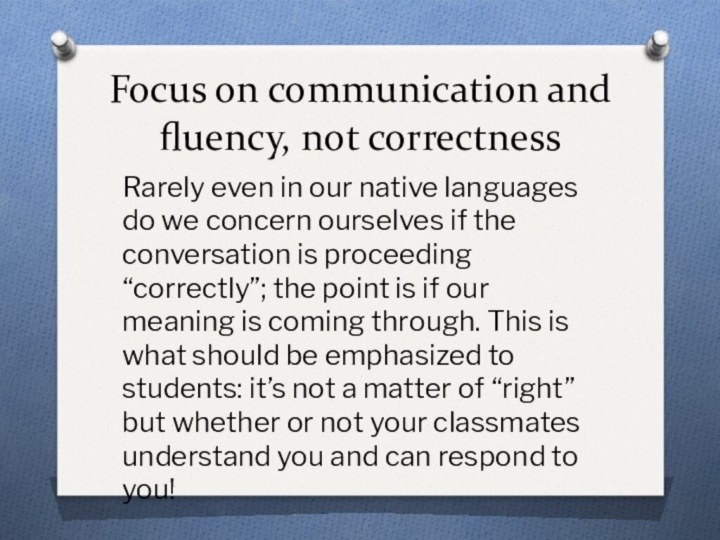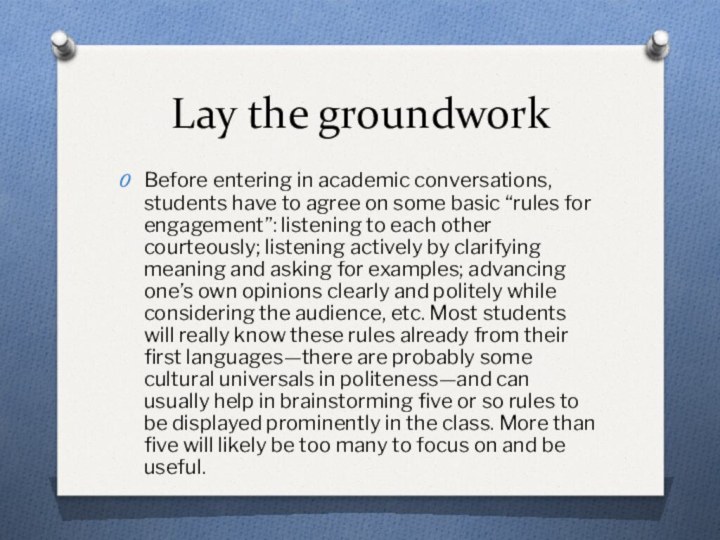Слайд 2
Lay the groundwork
Before entering in academic conversations, students
have to agree on some basic “rules for engagement”:
listening to each other courteously; listening actively by clarifying meaning and asking for examples; advancing one’s own opinions clearly and politely while considering the audience, etc. Most students will really know these rules already from their first languages—there are probably some cultural universals in politeness—and can usually help in brainstorming five or so rules to be displayed prominently in the class. More than five will likely be too many to focus on and be useful.
Слайд 3
Student directed: student choice of topics
There are few
things more uncomfortable than being in a conversation on
a topic you either intensely dislike or have nothing to say on.
Teachers should ask themselves the following: Are my students capable of listening to their peers on the topic without erupting in anger? Can they advance their own opinions without undue embarrassment?
Слайд 4
Small group/pair work
Conversation occurs in small, not large
groups. Having students work in small groups or pairs
is usually more productive for a number of reasons: students are less self-conscious if they are “performing” in front of a small group rather than large, and they have more chance to speak in a smaller group. In addition, conversations generally occur in smaller groups, as any party or meeting will demonstrate—people gather in small groups to talk when given the opportunity. Setting aside regular time for students to get into groups for discussion will help them develop their conversation skills.
Слайд 5
Encourage students to rotate partners
Some teachers assign conversational
partners or groups for the term, and this has
advantages, such as students get to know each other better this way, and they can quickly get into their groups when asked to, easing transitions. However, there also are advantages to occasionally rotating partners or groups, perhaps every few weeks. In this way, students get to know more of their peers and get exposed to more ideas while still having the structure provided by having a stable group for a period of time.
Слайд 6
Teach students strategies
Too often conversations even between native
speakers fall flat because the participants don’t know conversation
strategies. In addition, there is a difference between an everyday conversation and an academic conversation. Many if not all of our students can carry on an everyday conversation without much difficulty: “What would you like for dinner?” “I dunno. Pizza? Chicken? What do you want?” Much of our day-to-day “conversation” goes on in exchanges like this and requires few strategies. But to have a real “conversation” on the topic of food choices, for example, the conversational partners will have to know different strategies for introducing the topic, drawing each other out, asking for opinions, advancing their own, using examples, and so forth.
Слайд 7
Teach vocabulary
It seems elementary, but it is often
forgotten that students may not be participating because they
simply don’t have the vocabulary to enter a specific conversation. Introducing some key phrases and words related to the topic will help this. For example, on the topic of different types of vacations today, students should learn words like “condo,” “time share,” “hotel,” “motel,” “extended stay,” “business class,” and “coach.”
Слайд 8
Teach both formal and informal conversation skills
There are
specific strategies for entering, extending, and ending conversations both
formally and informally. For example, with “Hey, Diana! How was your vacation to Hawaii?” I am signaling to Diana that I’d like to open an informal and probably brief conversation on the topic of her vacation that might extend a little into my vacation and vacations in general. However, with “What do you think about how we vacation today? Hasn’t it changed quite a bit from even ten years ago?” I am signaling a different kind of conversation—more in-depth and analytical as the conversation participants consider different types of vacations, and more academic. Knowing these strategies for different types of conversations will help students avoid confusion and even annoyance and gain experience in different types of conversations.
Слайд 9
Grade on degree of participation and understanding of
conversation. Assess informally.







































